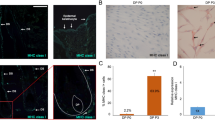Abstract
Factors that influence the growth of the anagen hair follicle or initiate the switch to a catagen growth pattern have so far not been definitely determined, but there is increasing evidence that cytokines and growth factors play an important role during these processes. Recently we detected an aberrant in situ expression pattern of cytokines of the Th1 type (IFNγ, IL-2) plus IL-1β expression in untreated alopecia areata (AA), and a switch to high levels of IL-10 TGF-β1 expression after successful treatment with the contact allergen diphenylcyclopropenone (DCP). Hence the question arose as to whether cytokines are able to arrest hair growth and whether IL-10 or TGFβ1 have the capacity to antagonize this process. Using whole-organ cultures of microdissected human hair follicles we studied the effect of a panel of cytokines and growth factors on hair growth and on the gross morphology of the hair follicles in vitro. IL-2, IL-10 and IFN-γ had no effect in this regard, whereas TGFβ1 partially inhibited hair growth and EGF, TNFα and IL-1β completely abrogated it. EGF and TNFα induced the formation of a club-like hair follicle, similar to catagen morphology of the hair bulb, whereas hair follicles grown in the presence of IL-1β or TGFβ1 showed no particular morphological changes. We conclude that cytokines and growth factors are pivotal regulators of hair growth at least in vitro. IL-1 is suggested as playing an important role during the pathogenesis of AA. Possible mediators of therapeutic contact dermatitis (IL-10, TGFβ1, TNFα, PGE2) are, at least in vitro, not able to antagonize the IL-1β-triggered hair growth inhibition. Therefore, we infer that these mediators rather ‘modulate’ the immune response in AA.
Similar content being viewed by others
Abbreviations
- AA :
-
alopecia areata
- IFN :
-
interferon
- TGF :
-
transforming growth factor
- EGF :
-
epidermal growth factor
- IL :
-
interleukin
- PG :
-
prostaglandin
- TNF :
-
tumor necrosis factor
References
Perret C, Wiesner-Menzel L, Happle R (1984) Immunohistochemical analysis of T-cell subsets in the peribulbar and intrabulbar infiltrates of alopecia areata. Acta Derm Venereol (Stockh) 64:26–30
Shapiro J, Tan J, Ho V, Abbott F, Tron V (1993) Treatment of chronic severe alopecia areata with topical diphenylcyclopropenone and 5% minoxidil: a clinical and immunopathologic evaluation. J Am Acad Dermatol 29:729–735
Hamm H, Klemmer S, Kreuzer I, Steijlen PM, Happle R, Bröcker E (1988) HLA-DR and HLA-DQ antigen expression of anagen and telogen hair bulbs in long-standing alopecia areata. Arch Dermatol Res 280:179–181
Baadsgaard O (1991) Alopecia areata: an immunologic disease? J Invest Dermatol 96:89S
Hoffmann R, Wenzel E, Huth A, Henninger HP, Steen P, Schäufele M, Happle R (1994) Cytokine mRNA levels in alopecia areata before and after treatment with the contact allergen diphenylcyclopropenone. J Invest Dermatol 103:530–533
Philpott MP, Green MR, Kealey T (1992) Rat hair growth in vitro. Br J Dermatol 127:600–607
Philpott MP, Green MR, Kealey T (1989) Studies on the biochemistry and morphology of freshly isolated and maintained rat hair follicles. J Cell Sci 93:409–418
Philpott MP, Green MR, Kealey T (1990) Human hair growth in vitro. J Cell Sci 97:463–471
Westgate GE, Gibson WT, Kealey T, Philpott MP (1993) Prolonged maintenance of human hair follicles in vitro in a serum-free medium. Br J Dermatol 129:372–379
Harmon CS, Nevis TD (1993) IL-1α inhibits human hair follicle growth and hair fibre production in whole-organ cultures. Lymphokine Cytokine Res 12:197–203
Harmon CS, Nevis TD (1994) Hair fibre production by human hair follicles in whole organ culture. Br J Dermatol 130:415–423
Jimenez JJ, Wong GH, Yunis AA (1991) Interleukin 1 protects from cytosine arabinoside-induced alopecia in the rat model. FASEB J 5:2456–2458
Groves RW, Williams IR, Sarkar S, Nakamura K, Kupper TS (1994) Analysis of epidermal IL-1 family members in vivo using transgenic mouse models. J Invest Dermatol 102:556
Philpott MP, Sanders D, Kealey T (1995) Cultured human hair follicles and growth factors. J Invest Dermatol 104:445
Hoffmann R, Wenzel E, Huth A, Steen P, Schäufele M, Happle R (1994) Diphenylcyclopropenone (DCP) therapy of alopecia areata is reflected by increased expression of TGF-β1 mRNA. Exp Dermatol 3:121
Dinarello C (1991) Interleukin-1 and interleukin-1 antagonism. Blood 77:1627–1652
Chantry D, Turner M, Abney E, Feldmann M (1989) Modulation of cytokine production by transforming growth factor-beta. J Immunol 142:4295–4301
Waal Malefyt R de, Haanen JBAG, Spits H, Roncarolo MG, Velde A te, Figdor CG, Johnson K, Kastelein R, Yssel H, Vries JE de (1991) IL-10 and viral IL-10 strongly reduce antigen presenting capacity of monocytes via downregulation of class II MHC expression. J Exp Med 174:915–924
Bröcker EB, Echternacht-Happle K, Hamm H, Happle R (1987) Abnormal expression of class I and class II major histocompatibility antigens in alopecia areata: modulation by topical immunotherapy. J Invest Dermatol 88:564–568
Author information
Authors and Affiliations
Rights and permissions
About this article
Cite this article
Hoffmann, R., Eicheler, W., Huth, A. et al. Cytokines and growth factors influence hair growth in vitro. Possible implications for the pathogenesis and treatment of alopecia areata. Arch Dermatol Res 288, 153–156 (1996). https://doi.org/10.1007/BF02505825
Received:
Issue Date:
DOI: https://doi.org/10.1007/BF02505825




